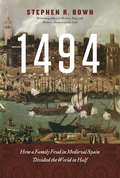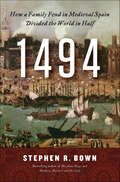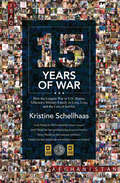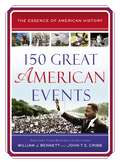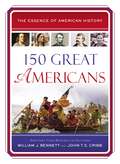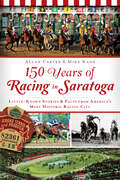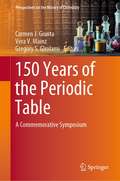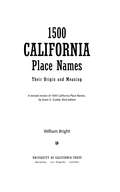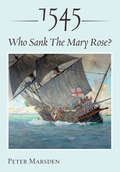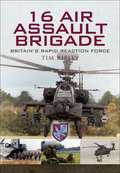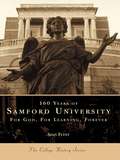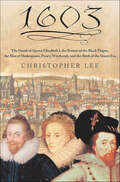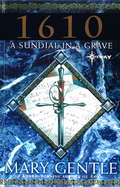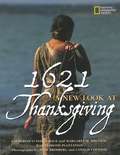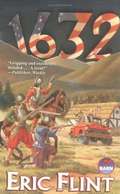- Table View
- List View
1494
by Stephen R. BownWhen Columbus triumphantly returned from America to Spain in 1493, his discoveries inflamed an already-smouldering conflict between Spain's renowned monarchs, Ferdinand and Isabella, and Portugal's João II. Which nation was to control the world's oceans? To quell the argument, Pope Alexander VI - the notorious Rodrigo Borgia - issued a proclamation laying the foundation for the Treaty of Tordesillas, an edict that created an imaginary line in the Atlantic Ocean dividing the entire known (and unknown) world between Spain and Portugal.Just as the world's oceans were about to be opened by Columbus's epochal voyage, the treaty sought to limit the seas to these two favoured Catholic nations. The edict was to have a profound influence on world history: it propelled Spain and Portugal to superpower status, steered many other European nations on a collision course and became the central grievance in two centuries of international espionage, piracy and warfare.At the heart of one of the greatest international diplomatic and political agreements of the last five centuries were the strained relationships and passions of a handful of powerful individuals. They were linked by a shared history, mutual animosity and personal obligations.
1494: How a Family Feud in Medieval Spain Divided the World in Half
by Stephen R. BownAn “exciting” account of the feud between monarchs, clergy, and explorers that split the globe between Spain and Portugal and made the oceans a battleground (Kirkus Reviews).When Columbus triumphantly returned to Spain in 1493, his discoveries inflamed an already-smoldering conflict between Spain’s monarchs, Ferdinand and Isabella, and Portugal’s João II. Which nation was to control the world’s oceans? To quell the argument, Pope Alexander VI—the notorious Rodrigo Borgia—issued a proclamation laying the foundation for the Treaty of Tordesillas of 1494, an edict that created an imaginary line in the Atlantic Ocean dividing the entire known (and unknown) world between Spain and Portugal.Just as the world’s oceans were about to be opened by Columbus’s epochal voyage, the treaty sought to limit the seas to these two favored Catholic nations. The edict had a profound influence on world history: it propelled Spain and Portugal to superpower status, steered other European nations on a collision course, and became the central grievance in two centuries of international espionage, piracy, and warfare.It also began the fight for “the freedom of the seas”—the epic struggle to determine whether the oceans, and thus global commerce, would be controlled by an autocrat’s decree or open to the ships of any nation—a distinctly modern notion championed in the early seventeenth century by Dutch legal theorist Hugo Grotius, whose arguments became the foundation of international law.At the heart of one of the greatest international diplomatic and political agreements of the last five centuries were the strained relationships and passions of a handful of powerful individuals. They were linked by a shared history, mutual animosity, and personal obligations—quarrels, rivalries, and hatreds that dated back decades. Yet the struggle ultimately stemmed from a young woman’s determination to defy tradition and the king, and to choose her own husband.“Incorporates a sprawling cast of characters, including Ferdinand and Isabella, Columbus, Magellan, Sir Francis Drake, and members of the ostentatious Borgia clan, into what is both a judicious synthesis of the surrounding scholarship and an entertaining look at the evolution of international law on the high seas.” —Booklist“A starry love story, a tale of seething jealousies and subterfuge, a political imbroglio, and religious cruelties. It sounds like Shakespeare and it could have very well been the plot of one of his plays.” —Toronto Star“An entertaining and elegantly written voyage into the treacherous seas of religious fanatics, greedy slavers, depraved autocrats, doomed indigenous peoples and desperately brave adventurers in search of fortune.” —Globe & Mail
14–18: Understanding the Great War
by Annette Becker Stéphane Audoin-RouzeauWith this brilliantly innovative book, reissued for the one-hundredth anniversary of the beginning of the First World War, Stéphane Audoin-Rouzeau and Annette Becker have shown that the Great War was the matrix from which all subsequent disasters of the twentieth century were formed. They identify three often neglected or denied aspects of the conflict that are essential for understanding the war: First, what inspired its unprecedented physical brutality, and what were the effects of tolerating such violence? Second, how did citizens of the belligerent states come to be driven by vehement nationalistic and racist impulses? Third, how did the tens of millions bereaved by the war come to terms with the agonizing pain? With its strikingly original interpretative strength and its wealth of compelling documentary evidence, 14–18: Understanding the Great War has established itself as a classic in the history of modern warfare.
15 Minutes: General Curtis LeMay and the Countdown to Nuclear Annihilation
by L. Douglas KeeneyPacked with startling revelations, this inside look at the secret side of the Cold War exposes just how close America came to total annihilation During the Cold War, a flight crew had 15 minutes to get their nuke-laden plane in the air from the moment Soviet bombers were detected—15 minutes between the earliest warning of an incoming nuclear strike and the first flash of an enemy warhead. This is the chilling true story of the incredibly risky steps our military took to protect us from that scenario, including: • Over two thousand loaded bombers that crossed American skies. They sometimes crashed and at least nine times resulted in nuclear weapons being accidentally dropped • A system that would use timers and rockets to launch missiles even after everyone was dead • Disastrous atmospheric nuclear testing including the horrific runaway bomb—that fooled scientists and put thousands of men in uniform in the center of a cloud of hot fallout • A plan to use dry lake beds to rebuild and launch a fighting force in the aftermath of nuclear war Based on formerly classified documents, military records, press accounts, interviews and over 10 years of research, 15 Minutes is one of the most important works on the atom bomb ever written.
15 Stars: Three Generals Who Saved the American Century
by Stanley WeintraubIn the closing days of World War II, America looked up to three five-star generals as its greatest heroes. George C. Marshall, Dwight D. Eisenhower, and Douglas MacArthur personified victory, from the Pentagon to Normandy to the Far East. Counterparts and on occasion competitors, they had leapfrogged each other, sometimes stonewalled each other, even supported and protected each other throughout their celebrated careers. In the public mind they stood for glamour, integrity, and competence. But for dramatic twists of circumstance, all three -- rather than only one -- might have occupied the White House. The story of their interconnected lives opens a fascinating window onto some of the twentieth century's most crucial events, revealing the personalities behind the public images and showing how much of a difference three men can make. Marshall and MacArthur were contemporaries and competitors. Eisenhower was MacArthur's underling, then Marshall's deputy, before becoming MacArthur's counterpart as a supreme commander, Ike in Western Europe, MacArthur in the Pacific. Each of the three five-star generals would go on to extraordinary postwar careers: MacArthur as a virtual viceroy of Japan, overseeing its transition to a new constitutional democracy, and then leading the UN forces in the Korean War; Marshall as secretary of state, author of the Marshall Plan, and winner of the Nobel Peace Prize; Eisenhower as president. Fifteen Stars presents the intertwined lives of these three great men against the sweeping background of six unforgettable decades, from two world wars to the Cold War. It is history at its most dramatic yet most personal -- a triumph for Stanley Weintraub, our preeminent military historian.
15 Years of War: How the Longest War in U.S. History Affected a Military Family in Love, Loss, and the Cost of Service
by Kristine Schellhaas&“First-time author Schellhaas presents a moving memoir of her life with her husband, Ross . . . after [he] is deployed to Iraq after the events of 9/11.&” —Publishers Weekly Less than 1 percent of our nation will ever serve in our armed forces, leaving many to wonder what life is really like for military families. He answers the call of duty in Afghanistan, Iraq, and the Pacific; she keeps the home fires burning. Worlds apart, and in the face of indescribable grief, their relationship is pushed to the limits. 15 Years of War provides a unique he said/she said perspective on coping with war in modern-day America. It reveals a true account of how a dedicated Marine and his equally committed spouse faced unfathomable challenges and achieved triumph, from the days just before 9/11 through fifteen years of training workups, deployments, and other separations. This story of faith, love, and resilience offers insight into how a decade and a half of war has redefined what it means to be a military family. &“[A] tough-minded but open-hearted memoir . . . a frank description of what it takes for a spouse and family to support a soldier. The Schellhaases&’ story is deeply personal and unique, but it will resonate with other families, both civilian and military.&” —Foreword Magazine &“Kristine Schellhaas is a beautiful and transcendent voice of truth and consequence, and her memoir, 15 Years of War, should be required reading for every American who wants to understand just exactly what they have asked of the chosen 1 [percent].&” —Angela Ricketts, author of No Man&’s War: Irreverent Confession of an Infantry Wife
150 Great American Events (Essence of American History)
by William J. Bennett John T.E. CribbAlmost a decade ago, author and educator William J. Bennett and John T. E. Cribb published a 365-day almanac of our nation's history. Now, in this new two-volume series compiled from The American Patriot&’s Almanac, Bennett and Cribb&’s masterful grasp of our history offers 150 examples of fascinating details of great American events.A two-volume series compiled from William J. Bennett's bestselling book, revised and updated.150 Great American Events includes:American drama and interesting facts about American figuresObscure details about American historyPatriotic facts to broaden one&’s sense of the pastBold personalities and internal conflictsDiscoveries, ideas, and moreIn these easy-to-read entries, historical American events reemerge not as cold facts or boring details in a textbook, but as authentic events experienced by full-blooded, heroic pioneers whose far-reaching vision forged our nation. Great for history buffs, homeschoolers, teachers, and people who are interested in American history.
150 Great Americans (Essence of American History)
by William J. Bennett John T.E. CribbAlmost a decade ago, author and educator William J. Bennett and John T. E. Cribb published a 365-day almanac of our nation's history. Now, in this new two-volume series compiled from The American Patriot&’s Almanac, Bennett and Cribb&’s masterful grasp of our history offers 150 examples of fascinating details of great Americans.A two-volume series compiled from William J. Bennett's bestselling book, revised and updated.150 Great Americans includes:American drama and interesting facts about important American figuresObscure details about American historyPatriotic facts to broaden one&’s sense of the pastBold personalities and internal conflictsDiscoveries, ideas, and moreIn these easy-to-read entries, historical Americans reemerge not as marble icons or dust-dry names in a textbook, but as full-blooded, heroic pioneers whose far-reaching vision forged our nation. Great for history buffs, homeschoolers, teachers, and people who are interested in American history.
150 Jahre Gesetzgebung in Deutschland: Entwicklungen des Gesetzgebungsverfahrens von der konstitutionellen Monarchie 1871 bis zur parlamentarischen Demokratie 2021
by Martin H. MöllersDieses Buch erläutert die verfassungsmäßige Ausgestaltung der Gesetzgebungsverfahren im Kaiserreich, in der Weimarer Republik und in der Bundesrepublik Deutschland im Zusammenhang. Dadurch wird nachvollziehbar, dass die Gesetzgebung der heutigen parlamentarischen Demokratie ihre Basis bereits in der konstitutionellen Monarchie des Deutschen Kaiserreichs vor 150 Jahren hat. Obwohl das Verfahren der Gesetzgebung im Kaiserreich vordemokratisch ausgestaltet war, sind ihre wesentlichen Merkmale bis heute unverändert. Welche Änderungen die Gesetzgebungsverfahren von Verfassung zu Verfassung im Einzelnen erfuhren, analysiert das Buch und stellt heraus, dass diese Änderungen vor allem das Bund-Länder-Verhältnis, die Volkssouveränität sowie den Einfluss der Grundrechte auf die Gesetzgebung betrafen. Dabei kommen auch Auffassungen der Staatsrechtslehre früherer Zeiten zur Rechtsstaatlichkeit zur Sprache, die immer noch zum derzeitigen Meinungsspektrum zählen, heute jedoch nicht mehr zu halten sind. Zudem dokumentiert das Buch, wer an den Gesetzgebungsverfahren offiziell und wer faktisch beteiligt war bzw. noch ist und welche politischen Einflussnahmen auf die Gesetzgebung im Lauf der Geschichte festzustellen sind. So wird u.a. dokumentiert, dass insbesondere der Mangel an Transparenz der Zusammenarbeit von Exekutive und Legislative mit Lobbyisten dazu führt, dass viele Gesetze einzelne Bevölkerungsgruppen oder Wirtschaftszweige bevorzugen.
150 Questions To A Guerrilla
by General Alberto BayoGeneral Alberto Bayo is possibly the one individual most responsible for Fidel Castro's military successes against the Batista regime. Find the answers to such questions as: What is the most efficient size of a guerrilla unit? How will new volunteers be trained? What should be done if the enemy fire on us by surprise?
150 Years of Racing in Saratoga: Little-Known Stories & Fact's from America's Most Historic Racing City (Sports Ser.)
by Allan Carter Mike KaneCelebrate a century and a half of horse racing in Saratoga Springs with stories of the events, horse and people who have made its summers so special.Since the inaugural meeting of August 1863, Saratoga Springs is home to one of the oldest sports venues in the country and has been the scene of memorable races, often featuring legends of the sport. Although some of the epic moments are still familiar today, such as Upset&’s defeat of Man o&’ War in the 1919 Sanford Memorial, many of the triumphs and defeats that were once famous have been forgotten. Few remember the filly Los Angeles, who thrived at Saratoga, winning sixteen stakes races, or the influential, sometimes suspicious, reasons why the track was closed three times for a total of six years. Authors Allan Carter and Mike Kane take a look back at these and other important but neglected stories and present statistics from the pre-NYRA years and a rundown of the greatest fields assembled at America&’s oldest track.&“As the subtitle promises, the book consists of unexpected tales regarding Saratoga people, horses, and happenings--things that even certain racing historians had no previous clue about. Kane and Carter are uniquely well-equipped to guide readers down this curious road less traveled.&” —Mary Simon, Daily Racing Forum
150 Years of the Periodic Table: A Commemorative Symposium (Perspectives on the History of Chemistry)
by Gregory S. Girolami Carmen J. Giunta Vera V. MainzThis book provides an overview of the origins and evolution of the periodic system from its prehistory to the latest synthetic elements and possible future additions. The periodic system of the elements first emerged as a comprehensive classificatory and predictive tool for chemistry during the 1860s. Its subsequent embodiment in various versions has made it one of the most recognizable icons of science. Based primarily on a symposium titled “150 Years of the Periodic Table” and held at the August 2019 national meeting of the American Chemical Society, this book describes the origins of the periodic law, developments that led to its acceptance, chemical families that the system struggled to accommodate, extension of the periodic system to include synthetic elements, and various cultural aspects of the system that were celebrated during the International Year of the Periodic Table.
1500 California Place Names
by William BrightThis is the new "pocket" version of the classic California Place Names, first published by California in 1949. Erwin G. Gudde's monumental work, which went through several editions during its author's lifetime, has now been released in an expanded and updated edition by William Bright. The abridged version, originally called 1000 California Place Names, has grown to a dynamic 1500 California Place Names in Bright's hands. Those who have used and enjoyed 1000 California Place Names through the decades will be glad to know that 1500 California Place Names is not only bigger but better. This handbook focuses on two sorts of names: those that are well-known as destinations or geographical features of the state, such as La Jolla, Tahoe, and Alcatraz, and those that demand attention because of their problematic origins, whether Spanish like Bodega and Chamisal or Native American like Aguanga and Siskiyou. Names of the major Indian tribes of California are included, since some of them have been directly adapted as place names and others have been the source of a variety of names. Bright incorporates his own recent research and that of other linguists and local historians, giving us a much deeper appreciation of the tangled ancestry many California names embody. Featuring phonetic pronunciations for all the Golden State's tongue-twisting names, this is in effect a brand new book, indispensable to California residents and visitors alike.
1545: Who Sank The Mary Rose?
by Peter MarsdenA &“wonderful&” account of the raising of a sixteenth-century warship, and answers to the long-running mysteries surrounding her loss (Naval Historical Foundation). In 1982, a Tudor Navy warship was raised in a major salvage project that represented a landmark in maritime archaeology. The Mary Rose had spent over four centuries underwater, and contained the skeletons of numerous sailors as well as many fascinating artifacts of the time. She is more than a relic, however. She has a story to tell, and her sinking in the Solent while under attack by the French, and the reasons for it, have intrigued historians for generations. With the benefit of access to her remains, archaeologists have been able to slowly unravel the mystery of her foundering on a calm summer&’s day in July 1545. This new book by a leading expert on the Mary Rose contains much information that is published for the first time. It provides the first full account of the battle in which Henry VIII&’s warship was sunk, and tells the stories of the English and French admirals. It examines the design and construction of the ship and how she was used, and finally makes clear who was responsible for the loss of the Mary Rose, after describing what happened onboard, deck by deck, in her last moments afloat. Includes photographs
1588: A Novel in Five Books (The\hew Cullan Mysteries Ser. #6)
by Shirley McKayStories starring a sleuthing Scottish lawyer: &“McKay&’s command of plot, place and character makes these 16th century St Andrews-set mysteries a delight.&” —The Scotsman A grisly murder. A vanishing corpse. A secret romance. A ghostly tale. An innocent accused. Set in the year of the Armada, 1588: A Calendar of Crime brings together five short stories featuring Hew Cullan. From the gruesome murder of a candlemaker to Spanish ghosts on Hallowmas, Shirley McKay delivers five gripping tales of mystery that will keep you reading long into the night. &“A fascinating evocation of the everyday life of ordinary Scots in the 1500s as well as series of first-rate stories. Her use of language is a delight, the sinewy and expressive Scots words aiding the creation of Cullen's very realistic world. McKay is to be congratulated for the continued quality and inventiveness of her tales.&” —The National
16 Air Assault Brigade: Britain's Rapid Reaction Force
by Tim RipleyAfter the S.A.S., 16 Brigade is the most high profile formation in the British Army but to date there has been no complete history of its operations and activities. The aim of this book is to produce a history of Britains Elite Rapid Reaction Force 16 Air Assault Brigade.It will provide a historical narrative of 16 Brigades operations since its formation in 1999. It explains the innovative tactics and operational procedures used by to move by air into battle. It covers military hardware, the Brigade has some of the UKs most advanced weapon system, including Apache attack helicopters. It will include the elite combat units including the Parachute Regiment and Pathfinders. Key personalities from the Brigade will be examined together with a comprehensive analysis of how the Brigade has performed and how it is likely to evolve in coming years.The Brigade is due to return to Afghanistan in 2008 so its public profile will remain high.
16 Words: William Carlos Williams and "The Red Wheelbarrow"
by Lisa RogersThis simple nonfiction picture book about the beloved American poet William Carlos Williams is also about how being mindful can result in the creation of a great poem like "The Red Wheelbarrow"--which is only sixteen words long."Look out the window. What do you see? If you are Dr. William Carlos Williams, you see a wheelbarrow. A drizzle of rain. Chickens scratching in the damp earth." The wheelbarrow belongs to Thaddeus Marshall, a street vendor, who every day goes to work selling vegetables on the streets of Rutherford, New Jersey. That simple action inspires poet and doctor Williams to pick up some of his own tools--a pen and paper--and write his most famous poem.In this lovely picture book, young listeners will see how paying attention to the simplest everyday things can inspire the greatest art, as they learn about a great American poet.
160 Years of Samford University: For God, For Learning, Forever
by Sean FlyntSamford University, established in 1841 as Howard College, is a treasured institution of higher learning in Alabama, consistently ranked among the best regional universities in the nation. Well known for the quality of education it offers and for its stunning Georgian-Colonial campus, Samford boasts a long and fascinating history, illuminated here in acollection of vintage photographs. With images ranging from informal to formal, routine to remarkable, tragic to hilarious, this engaging retrospective delves into the heart of the school's heritage--its people. The aspirations of all who have called Samford home and those who have supported its mission come to life in snapshot memories of centuries past. Highlights of the book include extensive coverage of the East Lake campus years; the first experiment in coeducation; the earliest known photographs of the Marion campus;the infamous "liberation" of a rival college's mascot; the courage of student journalists in the 1970s; the story of Harry, the slave who gave his life saving students; and Samford University's latest educational innovations and architectural marvels. Rarely seen photographs from the university's Special Collection department, supplemented by informative, entertaining captions, offer Samford students, faculty, staff, alumni, and friends a chance to relive some of the most memorable moments in the school's history.
1603: The Death of Queen Elizabeth I, the Return of the Black Plague, the Rise of Shakespeare, Piracy, Witchcraft, and the Birth of the Stuart Era
by Christopher Lee1603 was the year that Queen Elizabeth I, the last of the Tudors, died. Her cousin, Robert Carey, immediately rode like a demon to Scotland to take the news to James VI. The cataclysmic time of the Stuart monarchy had come and the son of Mary Queen of Scots left Edinburgh for London to claim his throne as James I of England. Diaries and notes written in 1603 describe how a resurgence of the plague killed nearly 40,000 people. Priests blamed the sins of the people for the pestilence, witches were strangled and burned and plotters strung up on gate tops. But not all was gloom and violence. From a ship's log we learn of the first precious cargoes of pepper arriving from the East Indies after the establishment of a new spice route; Shakespeare was finishing Othello and Ben Jonson wrote furiously to please a nation thirsting for entertainment. 1603 was one of the most important and interesting years in British history. In 1603: The Death of Queen Elizabeth I, the Return of the Black Plague, the Rise of Shakespeare, Piracy, Witchcraft, and the Birth of the Stuart Era, Christopher Lee, acclaimed author of This Sceptred Isle, unfolds its story from first-hand accounts and original documents to mirror the seminal year in which Britain moved from Tudor medievalism towards the wars, republicanism and regicide that lay ahead.
1607: A New Look at Jamestown
by Karen LangeThe pages come alive with Ira Block's stunning photography, detailing newly discovered artifacts, and highlighting authentic Jamestown reenactments. Compelling new theories, a National Geographic period map, and stunning reenactment photography take us back to Jamestown in 1607, where the course of our country's history changed forever.
1610: A Sundial In A Grave
by Mary GentleThe year is 1610. Continental Europe is briefly at peace after years of war, but Henri IV of France is planning to invade the German principalities. In England, only five years earlier, conspirators nearly succeeded in blowing up King James I and his Parliament. The seeds of the English Civil War and the Thirty Years War are visibly being sown, and the possibility for both enlightenment and disaster abounds.But Valentin Rochefort, duelist and spy for France's powerful financial minister, could not care less. Until he is drawn into the glittering palaces, bawdy back streets, and stunning theatrics of Renaissance France and Shakespearean London in a deadly plot both to kill King James I and to save him. For this swordsman without a conscience is about to find himself caught between loyalty, love, and blackmail, between kings, queens, politicians, and Rosicrucians, and the woman he has, unknowingly, crossed land and sea to meet.
1616: The World in Motion
by Thomas ChristensenThe world of 1616 was a world of motion. Enormous galleons carrying silk and silver across the Pacific created the first true global economy, and the first international megacorporations were emerging as economic powers. In Europe, the deaths of Shakespeare and Cervantes marked the end of an era in literature, as the spirit of the Renaissance was giving way to new attitudes that would lead to the Age of Revolution. Great changes were also taking place in East Asia, where the last native Chinese dynasty was entering its final years and Japan was beginning its long period of warrior rule. Artists there, as in many parts of the world, were rethinking their connections to ancient traditions and experimenting with new directions. Women everywhere were redefining their roles in family and society. Slave trading was relocating large numbers of people, while others were migrating in search of new opportunities. The first tourists, traveling not for trade or exploration but for personal fulfillment, were exploring this new globalized world.
1619: Jamestown and the Forging of American Democracy (Published By The Omohundro Institute Of Early American History And Culture And The University Of North Carolina Press Ser.)
by James HornAn extraordinary year in which American democracy and American slavery emerged hand in handAlong the banks of the James River, Virginia, during an oppressively hot spell in the middle of summer 1619, two events occurred within a few weeks of each other that would profoundly shape the course of history. In the newly built church at Jamestown, the General Assembly--the first gathering of a representative governing body in America--came together. A few weeks later, a battered privateer entered the Chesapeake Bay carrying the first African slaves to land on mainland English America.In 1619, historian James Horn sheds new light on the year that gave birth to the great paradox of our nation: slavery in the midst of freedom. This portentous year marked both the origin of the most important political development in American history, the rise of democracy, and the emergence of what would in time become one of the nation's greatest challenges: the corrosive legacy of racial inequality that has afflicted America since its beginning.
1621: A New Look At Thanksgiving
by Catherine O'Neill Grace Cotton Coulson Sisse Brimberg Margaret M. Bruchac Plimoth PlantationIn cooperation with the Plimoth Plantation, a living-history museum in Massachusetts, National Geographic has recreated the first Thanksgiving. Photographs by National Geographic photographers of the recreation at Plimoth Plantation illustrate this book. In 1621, in a small settlement on the edge of the sea, 52 English colonists celebrated their first harvest. The colonists were joined by 90 men of the Wampanoag tribe for a gathering that was to last three days in a town now known as Plymouth. Over the centuries, there have been countless versions of this story, creating a popular myth of the first Thanksgiving. Many Americans imagine brave, peaceful settlers inviting a few wild Indians over for a turkey dinner. But there was no pumpkin pie or cranberry sauce at this celebration. There were no Indians with woven blankets over their shoulders and large feathered headdresses. No pilgrims with somber black clothes and silver buckle hats either. The English didn't even call themselves Pilgrims. This book puts aside that myth and takes a new look at our American history. It questions what we know and recovers lost voices of the Wampanoag people. True history includes the voices of all its participants. 1621: A New Look at Thanksgiving invites young people to read, listen, and think about our shared history. The book also features a foreword, a section on the actual reenactment and the concept of living history, a chronology, an index, and a bibliography.
1632
by Eric FlintFREEDOM AND JUSTICE -- AMERICAN STYLE1632 And in northern Germany things couldn't get much worse. Famine. Disease. Religous war laying waste the cities. Only the aristocrats remained relatively unscathed; for the peasants, death was a mercy.2000 Things are going OK in Grantville, West Virginia, and everybody attending the wedding of Mike Stearn's sister (including the entire local chapter of the United Mine Workers of America, which Mike leads) is having a good time.THEN, EVERYTHING CHANGED....When the dust settles, Mike leads a group of armed miners to find out what happened and finds the road into town is cut, as with a sword. On the other side, a scene out of Hell: a man nailed to a farmhouse door, his wife and daughter attacked by men in steel vests. Faced with this, Mike and his friends don't have to ask who to shoot. At that moment Freedom and Justice, American style, are introduced to the middle of the Thirty Years' War.
